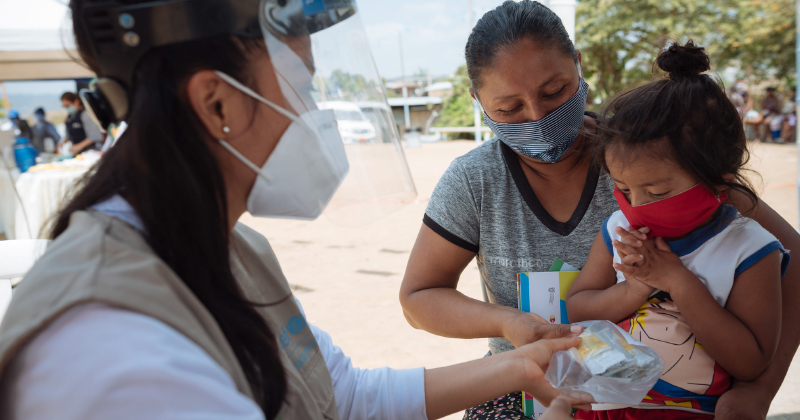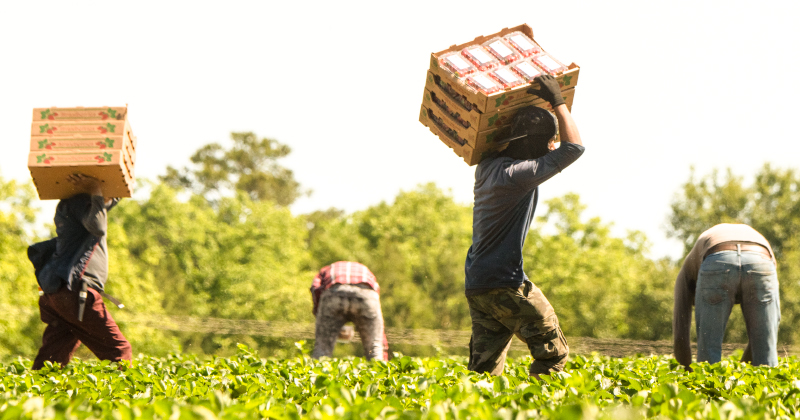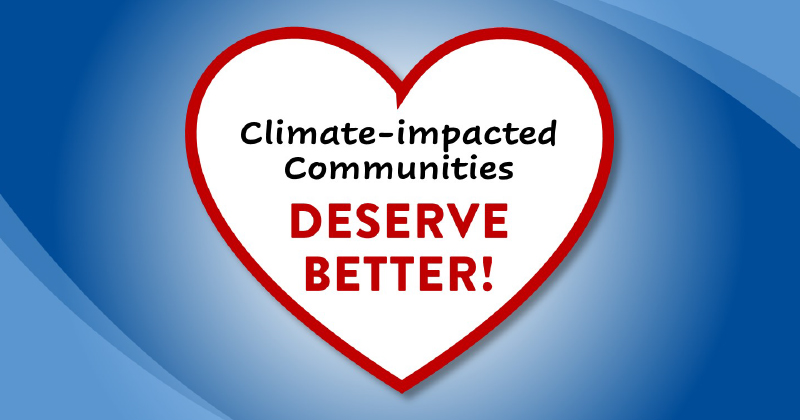- Who We Are
- Clinician Employment
- Publications
- Witness to Witness (W2W)
- Kugel & Zuroweste Health Justice Award
- Your Voice Matters: Photovoice Project
Tue, 12/28/2021 | by Myrellis Muñiz-...

[Editor’s Note: In this post, Myrellis Muñiz-Márquez, MCN’s Puerto Rico Program Manager, delineates some of the ways that the climate crisis is exacerbating health inequities. MCN’s Puerto Rico office has several initiatives aimed at protecting the health and well-being of historically marginalized members of communities when climate-fueled disasters strike. You can support their efforts with a donation to MCN during our end-of-year campaign. Help us reach our $40,000 goal – donate here.]
The climate crisis is constantly transforming the world as we know it. Alterations in climate patterns that previously took centuries to develop are now evident in only decades or even less. Rising temperatures degrade our environment, fuel extremely aggressive natural disasters and phenomena, acidify oceans, burn forests, melt the arctic, and raise sea levels. Our thoughtless actions seeking progress and advancement continue to lead us to a vastly different future than the one we dreamed of, a future where we must grapple with food and water insecurity, economic disruption, displacement, and loss of human life. In modern democratic society, the government has the responsibility to secure their citizens’ unalienable and equitable rights, opportunities, and resources. But as the climate crisis spirals out of control, not everyone is affected equally.
Historically marginalized communities experience climate impact differently, as they already disproportionately experience the effects of inequitable systems. For marginalized communities, including Latino/Latinx, Black, Indigenous peoples, and LGBTQIA+ communities and other communities of color, the social, economic, and political framework merged with the climate crisis becomes a deadly combination. Unequal access to a clean environment or basic environmental resources due to race and ethnicity; residence in areas with a higher risk of environmental issues, heavy pollution and hazardous waste; and racially or ethnically-biased government response to environmental concerns are some of the reasons these groups face such elevated risks.

The single most common and profound climate change consequence among Latino/Latinx and other communities is migration.1 The instability fueled by lack of work, food, and shelter in their home countries is substantially due to climate change and the degradation of local ecosystems. The agricultural industry in Central America and the Caribbean has suffered extraordinary damage due to extreme changes in precipitation patterns, droughts, flooding, and hurricanes, among other concerns directly linked to climate change.2 A United Nations climate change report showed that loss of crops is the second-largest migration factor among those living in the dry corridor of the Pacific Coast. The same report shows how crop shortages linked to climate change led to extreme poverty and hunger.3
In the United States, historic segregation has resulted in African Americans, people of color, and low-income communities living in undesirable low-lying and flood-prone areas. By 2019, more than half of African Americans in the United States lived in the South, an area that is seeing and will continue to see stronger hurricanes and increased flooding from climate change.4 Many communities next to power plants, petrochemical plants factories, and other sources of pollution are African American or other people of color. A study showed the population in Cancer Alley, Louisiana, which is mostly composed of Black residents and people with low socioeconomic indicators, is disproportionately exposed to major air toxins compared to three relevant reference groups, making it a region of excessively high cancer risk. Compelling evidence points to disparities in cancer risk based on income and race in Cancer Alley.5 These risks are amplified by climate change and weather events promoting non-point source pollution, where contaminants are carried directly to the homes in these communities and their water sources.

Heat stress will continue to increase the work-related health risks faced by low-wage work, in fields and orchards, as well as in unconditioned warehouses and trucks. Heat stress alone is dangerous, but its impact is often multiplied by inequities and other aspects of the climate crisis. For example, smoke from climate-induced fires increases the risk of heat stress and other health complications, yet few policies and protections exist to protect low-wage workers from heat stress or smoke exposure.
Another of the effects of the climate crisis is ocean acidification, which affects natural plant and animal life which can negatively impact humans such as coastal Native American tribes who rely on the ocean for food, economic, and other purposes.6
LGBTQIA+ people are more vulnerable to the harmful impacts of the climate crisis as they are more likely to be living on lower incomes, experiencing homelessness, and having limited access to health care.7 A report published in September 2021 by DRR Dynamics Ltd highlights discrimination against the LGBTQIA+ community during the disaster response phase, including the lack of provision of appropriate aid and assistance.8 Research has also highlighted that the exclusion and marginalization of LGBTQIA+ populations in disaster settings can directly impact health needs, with basic medical and health-based considerations often failing to be met.9
Migrant Clinicians Network advocates for environmental justice and defends the right to live in a healthy environment. Migrants, asylum-seekers, and historically marginalized communities deserve climate change adaptation efforts that ensure equal rights, opportunities, and treatment, while mitigating their particular vulnerabilities and needs. A human rights-based approach is desperately needed where race, ethnicity, and sexual or gender identity do not hinder people's rights, opportunities, and aid.
At Migrant Clinicians Network, we employ a multitiered approach as the climate crisis grows. We equip clinicians in the exam room to know the impacts on health that climate-related disasters have on their community. We work directly with communities to build disaster preparedness, where the health workers know where the most vulnerable community members live and what their needs are. We are pushing hard and will continue to fight, for federal protections on heat, and for more action to reduce the speed of the climate crisis. Climate-impacted communities deserve better.

Support the health of those most impacted by the climate crisis by donating to Migrant Clinicians Network. We are nearing the end of our fundraising campaign and still need to get to $40,000 to support these important efforts! Donate now: www.migrantclinician.org/donate.
Got some good news to share? Contact us on our social media pages above.
Return to the main blog page or sign up for blog updates here.
1 National Academies of Sciences, Engineering, and Medicine. Attribution of Extreme Weather Events in the Context of Climate Change. The National Academies Press; 2016.
2 Food and Agriculture Organization of the United Nations. Disaster risk program to strengthen resilience in the dry corridor in Central America. September 2015. Accessed December 21, 2021. http://www.fao.org/fileadmin/user_upload/emergencies/docs/Corredor_Seco_Breve_EN.pdf
3 Intergovernmental Panel on Climate Change. (2019). Climate change and land: an IPCC special report on climate change, desertification, land degradation, sustainable land management, food security, and greenhouse gas fluxes in terrestrial ecosystems. Accessed December 21, 2021. https://www.ipcc.ch/srccl/
4 Tamir, C., Budiman, A., Noe-Bustamante, L., & Mora, L. (2021, December 15). Facts about the U.S. Black population. Pew Research Center's Social & Demographic Trends Project. Retrieved December 21, 2021, from https://www.pewresearch.org/social-trends/fact-sheet/facts-about-the-us-black-population/
5 James, W., Jia, C., & Kedia, S. (2012). Uneven magnitude of disparities in cancer risks from air toxics. International journal of environmental research and public health, 9(12), 4365–4385. https://doi.org/10.3390/ijerph9124365
6 Environmental Protection Agency. (2021, November 26). Effects of Ocean and Coastal Acidification on Ecosystems. EPA. Retrieved December 21, 2021, from https://www.epa.gov/ocean-acidification/effects-ocean-and-coastal-acidification-ecosystems]
7 Burwick, A., Gates, G., Baumgartner, S., & Friend, D. (2014, December). Human services for low-income and at-risk LGBT populations: An assessment of the knowledge base and research needs. Administration for Children and Families. Retrieved December 21, 2021, from https://www.acf.hhs.gov/sites/default/files/documents/opre/lgbt_hsneeds_assessment_reportfinal1_12_15.pdf
8 Seglah, H A & Blanchard, K (2021) LGBTQIA+ People and Disasters. Accessed from https://bit.ly/DRR_LGBT_Rept.
9 Rumbach J and Knight K (2014), Sexual and Gender Minorities in Humanitarian Emergencies, in Issues of Gender and Sexual Orientation in Humanitarian Emergencies, Springer.







